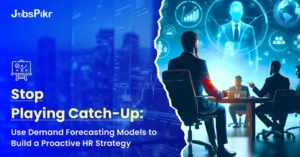You might have already heard about workforce analysis, but do you truly understand its strategic power? Beyond being an HR buzzword, workforce analysis is a proactive, data-driven compass guiding organizations through talent challenges and future uncertainties. When leveraged strategically, it transforms HR from a support function into a critical strategic partner, ensuring your organization has the right people, with the right skills, in the right roles, at the right time, and at the right cost.
What is Workforce Analysis?
Workforce analysis is the systematic process of collecting, interpreting, and applying workforce data (like skills, demographics, performance, tenure, compensation, and turnover) alongside business metrics (including ROI, productivity, and market trends). It moves beyond simple headcounts to uncover deep insights that inform critical decisions about:
- Talent Acquisition & Retention: Identifying skill gaps, predicting turnover risks, optimizing hiring strategies.
- Succession Planning: Pinpointing future leaders and critical role vulnerabilities.
- Learning & Development: Tailoring training programs to address specific skill shortages and future needs.
- Restructuring & Redeployment: Optimizing organizational design and efficiently moving talent where it’s needed most.
- Cost Management: Analyzing compensation competitiveness, benefits utilization, and overall workforce cost efficiency.
- Diversity, Equity & Inclusion (DEI): Tracking progress, identifying barriers, and measuring the impact of initiatives.
Core Objectives: The ultimate goals of effective workforce analysis are to:
- Maintain Optimal Staffing Levels: Avoid costly overstaffing or crippling understaffing.
- Ensure Critical Competencies: Guarantee the organization possesses the essential skills needed to execute its strategy now and in the future.
- Optimize Workforce Costs: Achieve the best possible return on human capital investment.
- Build Organizational Resiliency: Enable the workforce to adapt swiftly to market shifts, technological change, or economic downturns.
Achieving these objectives hinges on accurately identifying and forecasting the future demand for specific skills and roles (demand) against the projected internal and external supply of talent (supply).
Impact of Workforce Analysis on the HR Department
Workforce analysis elevates the HR department from an administrative function to a strategic powerhouse, fundamentally changing how it operates and the value it delivers:
- Evidence-Based Recruiting Decisions:
- Beyond Eliminating Misfits: Analytics allows HR to proactively attract high-potential candidates by identifying the traits and sources of top performers. It optimizes job descriptions, sourcing channels, and assessment techniques.
- Predictive Power: Go beyond past data. Predictive models can forecast candidate success and cultural fit with greater accuracy, significantly reducing costly mis-hires.
- Efficiency Gains: Automating resume screening and streamlining interview processes frees up HR time for strategic relationship building and candidate experience enhancement.
- Proactive Strategy Formulation:
- From Reactive to Predictive: Instead of just reporting past turnover, analytics predicts future flight risks, allowing targeted retention efforts before key talent leaves. It anticipates skill obsolescence due to automation or market changes.
- Scenario Planning: Model the impact of different business strategies (e.g., entering a new market, launching a product) on workforce needs. Quantify the ROI of different talent initiatives (e.g., upskilling vs. hiring).
- Data-Driven Workforce Planning: Move from annual headcount plans to dynamic, skills-based plans aligned with long-term business objectives.
- Driving Business Strategy & Employee Experience:
- Strategic Partnering: HR armed with workforce insights becomes a key advisor to the C-suite. They provide data on how talent trends impact revenue, innovation, customer satisfaction, and operational efficiency.
- Enhancing EX: Identify pain points in the employee lifecycle (e.g., high drop-off in onboarding, low engagement in specific departments) through data and implement targeted improvements.
- Demonstrating HR’s Value: Quantify the impact of HR programs (e.g., showing how reduced turnover saved $X, or how a leadership program improved productivity by Y%). Shift from “cost center” to “value creator.”
- Enabling Sustainable Growth & Accountability:
- Learning from the Past: Analyze historical hiring patterns, promotion rates, turnover reasons, and training effectiveness. Understand what worked and what didn’t to avoid repeating costly mistakes.
- Future-Proofing: Identify emerging skill requirements and develop strategies (internal development, targeted hiring) to bridge future gaps, ensuring the organization is prepared for growth and change.
- Promoting Transparency & Accountability: Data-driven insights foster objective discussions about talent needs, performance gaps, and diversity goals, holding leaders and HR accountable for workforce outcomes.
Best Practices to Conquer the Planning Process with Workforce Analysis

Workforce analytics isn’t just an upgrade; it’s a fundamental metamorphosis for the HR function. It shifts HR from a reactive, administrative support role to a proactive, data-driven strategic partner, fundamentally altering its operational DNA and the demonstrable value it delivers to the entire organization. Here’s how this transformation manifests across key areas:
1. Evidence-Based Recruiting Decisions: Precision Hiring at Scale
- Beyond Eliminating Misfits: Analytics empowers HR to move beyond simply screening out bad fits. It enables the proactive attraction of high-potential candidates by:
- Talent Profiling: Identifying the specific competencies, experiences, and even personality traits (where legally compliant) that correlate with top performance in specific roles. Example: Analysis reveals that successful sales reps share traits like resilience and specific consultative questioning techniques.
- Source Optimization: Pinpointing the most effective channels (e.g., niche job boards, specific universities, employee referrals) for finding candidates with these high-potential profiles. Example: Data shows 40% of top engineers come from employee referrals, leading to a revamped referral bonus program.
- JD & Process Refinement: Continuously A/B testing job descriptions, application questions, and assessment tools to maximize applications from target profiles and predict success. Example: Changing “requires 5 years experience” to “demonstrated experience in X” increased qualified female applicants by 25%.
- Predictive Power:
- Success Forecasting: Advanced models analyze past hiring data, assessment results, and early performance indicators to predict a candidate’s likelihood of success, cultural integration, and long-term retention before the offer is made. *Example: Predictive scoring flags candidates with a 70 %+ probability of exceeding performance targets within 18 months.*
- Reducing Costly Mis-Hires: Quantifying the true cost of a bad hire (recruitment fees, onboarding, lost productivity, impact on team morale) makes the ROI of predictive accuracy crystal clear. *Example: Reducing the mis-hire rate by 15% saves the company an estimated $1.2M annually.*
- Efficiency Gains:
- Intelligent Automation: AI-powered tools handle initial resume screening, schedule interviews, and even conduct preliminary assessments, freeing significant HR bandwidth. *Example: Automating initial screening reduced time-to-review by 65%.*
- Focus on High-Value Activities: Liberated from administrative burdens, recruiters and HRBPs can focus on strategic sourcing, building talent pipelines, enhancing candidate experience, and building relationships with hiring managers. Example: Recruiters now spend 50% more time on strategic talent sourcing and manager consulting.
2. Proactive Strategy Formulation: Anticipating Needs, Shaping the Future
- From Reactive to Predictive:
- Flight Risk Identification: Analyzing engagement survey data, performance trends, compensation benchmarks, and even subtle behavioral signals (e.g., decreased network activity) to predict which high-value employees are most likely to leave. Example: Model identifies 15 key engineers with >60% flight risk, triggering personalized retention plans.
- Skill Gap & Obsolescence Forecasting: Mapping current skills against future business strategy and technological trends to identify critical emerging skill needs and roles at risk of becoming obsolete. *Example: Analytics predicts a 40% deficit in AI/ML skills needed for the new product line launch in 18 months.*
- Scenario Planning & ROI Quantification:
- Workforce Modeling: Simulating the impact of business decisions (e.g., market expansion, M&A, automation projects) on workforce size, composition, and cost. *Example: Modeling shows entering Market Y requires hiring 50 new sales reps but automating process Z reduces back-office staff by 20.*
- Talent Initiative ROI: Calculating the projected return on investment for different solutions to talent gaps (e.g., cost/benefit of upskilling 100 internal staff vs. hiring 30 external experts vs. outsourcing). *Example: Analysis shows upskilling internal IT staff on cloud tech has a 2-year ROI of 150% vs. hiring externally.*
- Data-Driven Workforce Planning:
- Skills-Centric Planning: Moving beyond static headcounts to dynamic plans focused on the specific skills and capabilities required to execute the business strategy. Example: Workforce plan prioritizes building data literacy across marketing and operations teams over the next two years.
- Integrated with Business Cycles: Aligning workforce planning tightly with financial planning and operational cycles, moving away from rigid annual exercises. Example: Quarterly workforce reviews adjust hiring targets based on real-time sales forecasts and project pipelines.
3. Driving Business Strategy & Elevating the Employee Experience (EX)
- Strategic Partnering at the Executive Level:
- Linking Talent to Business Outcomes: HR provides the C-suite with irrefutable data on how talent strategies directly impact core metrics like revenue per employee, customer satisfaction scores (NPS/CSAT), time-to-market for new products, and operational efficiency. Example: Presentation to CEO shows a 10% increase in manager quality (via 360 data) correlates with a 5% increase in team productivity and 3% higher customer retention.
- Informing Strategic Choices: Providing insights on workforce readiness, risks, and opportunities that shape major business decisions. Example: HR data on the scarcity and cost of specialized cybersecurity talent influences the board’s decision to acquire a smaller firm with that expertise.
- Enhancing EX Through Data-Driven Insights:
- Identifying Lifecycle Friction Points: Pinpointing exact stages where employee dissatisfaction or drop-off occurs (e.g., high early turnover in specific departments, low engagement after 3 years, bottlenecks in promotion processes) using survey data, exit interviews, and system analytics. Example: Analysis reveals a 30% drop in engagement scores during the second performance review cycle, prompting a revamp of the feedback process.
- Targeted Interventions: Implementing data-informed programs to address specific EX pain points, measure their effectiveness, and iterate. *Example: Launching a personalized onboarding “buddy” program in high-turnover departments reduced 90-day attrition by 22%.*
- Demonstrating HR’s Tangible Value:
- Quantifying Impact: Moving beyond activity metrics (e.g., “hired 100 people”) to outcome metrics that show HR’s contribution to the bottom line and strategic goals.
- Turnover Cost Savings: “Targeted retention initiatives for high-risk roles saved $850k in replacement costs last year.”
- Productivity Gains: “Leadership development program cohort showed a 12% average increase in team output metrics.”
- Quality of Hire: “New hires sourced via optimized channel X have 20% higher first-year performance ratings.”
- Shifting Perception: Consistently demonstrating this value transitions HR from being seen as a cost center to being recognized as a critical value creator and strategic enabler.
- Quantifying Impact: Moving beyond activity metrics (e.g., “hired 100 people”) to outcome metrics that show HR’s contribution to the bottom line and strategic goals.
4. Enabling Sustainable Growth & Fostering Accountability
- Learning from the Past:
- Historical Pattern Analysis: Deep dives into data reveal the true drivers of past successes and failures. Analyze promotion rates by demographic group to uncover bias, correlate training participation with performance lifts, or understand the root causes of historical turnover spikes. Example: Analysis shows past restructuring failed because critical institutional knowledge wasn’t mapped or retained.
- Avoiding Costly Repetition: This historical insight prevents organizations from making the same expensive mistakes. Example: Learning that rapid growth without proper manager training led to burnout and turnover, the current expansion plan includes mandatory new-manager academies.
- Future-Proofing the Workforce:
- Bridging the Emerging Skills Gap: Proactively identifying skills needed for future strategies (e.g., sustainability expertise, advanced data analytics) and developing clear pathways (internal upskilling/reskilling programs, targeted external hiring, strategic partnerships) to acquire them. Example: Partnering with a coding bootcamp to reskill 50 operations staff into data analysts over 12 months.
- Building Adaptability: Using analytics to identify employees with high learning agility and potential for lateral moves, creating a more flexible and resilient workforce. Example: Skills inventory identifies 120 employees with adjacent skills who could be rapidly redeployed if market conditions shift.
- Promoting Transparency & Accountability:
- Objective Talent Discussions: Data replaces gut feeling and bias in conversations about performance, potential, promotions, and talent needs. Example: Promotion committees review calibrated performance data and potential assessment scores alongside manager recommendations.
- Tracking Progress on Goals: Setting clear, data-driven targets for diversity, retention, skill development, and manager effectiveness, and regularly reporting progress to leadership and the wider organization. *Example: Quarterly dashboard shows progress towards 3-year goals for female representation in leadership roles.*
- Holding Leaders Accountable: Providing managers with data on their team’s engagement, performance, and development progress, linking people management effectiveness to leadership performance reviews. Example: 30% of a manager’s bonus is tied to team engagement scores and development goal completion.
In essence, workforce analytics provides the evidence, foresight, and measurement capability that allows HR to confidently step into its role as a strategic architect of the organization’s most valuable asset – its people. This transformation is not just beneficial for HR; it’s essential for any organization aiming for sustainable, data-informed growth in a complex talent landscape.
Bottom Line on Workforce Analysis
Workforce analytics helps an organization to function and address challenges more efficiently. It ensures better employee management. Workforce analytics uses algorithms that can be programmed to apply to primary talent management.



